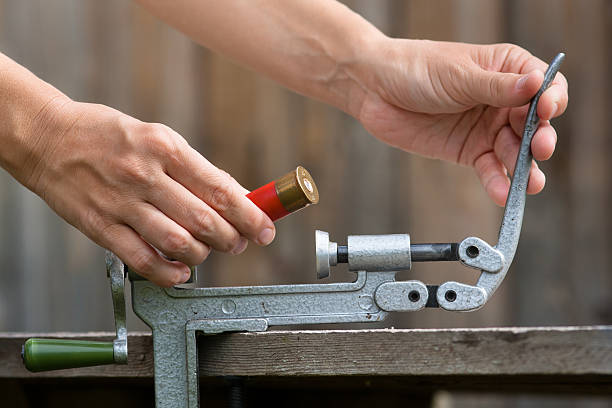
As a general rule, you should have several hundred or a couple of thousand rounds on hand or at least the reloading supplies for your most essential and most used calibers. You also want other reloading supplies that give you the flexibility to manufacture alternative rounds.
Here are the basics to get started:
-
Reloading Bench
You probably want to do some reading and research before getting started but when you’re ready to take action, the first two things you want in your reloading factory are a workbench and a trusted manual. Preferably a large sturdy workspace with plenty of storage. For details about creating your first workspace, check out the previous blog Workbench Ideas for Your Reloading Supplies. If you’re not going to build your own, any highly stable and strong commercially available workbench will work.
It does need to serve two primary purposes. First, a place to prepare cases and to operate your press. Second, a place to store reloading supplies, sorted brass, and finished ammo. You want to keep everything within arm’s reach but use special caution when storing primers and powder. The first thing that goes on your bench, in a dedicated space, and within arm’s reach is your trusted manual.
-
Reloading Press
Now, you are ready to start making decisions based on your experience, needs, and budget. You can select from a single stage press, turret press, or progressive press. Almost every experienced reloader recommends starting with a single stage. These presses hold one die at a time in a very rigid frame. Each pull of the lever completes one step of the process. Things to consider include automatic primer arm, small and large primer cups, adjustable for right- or left-hand use, and able to reload handgun and short rifle cases.
With a turret press, you rotate the dies manually and press the round through each step. It should hold four dies so that you can complete rounds without the time-consuming need to change dies. With each handle pull, the die plate rotates to the next station without needing to screw in a different die.
With a progressive press, a pull of the lever automatically completes every step for multiple rounds at the same time. This can be an excellent choice if you are shooting more than 500 rounds a week. Removable turrets allow for the change of calibers in seconds.
Unless you’re shooting precision bench rest competition, all the name-brand presses do mostly the same thing and in the same way. If you’re on a budget, it’s hard to beat the Lee Precision Breech Lock Challenger Kit.
-
Reloading Supplies -Dies, Components, and Case Prep
All reloading presses take removable dies. You select dies depending on the caliber you will be reloading. You will also need different dies depending on what step you’re at in the process. A die is what the brass and bullet are pressed into to form your finished ammo. Every caliber has its own die; a .357 die will not load a 9mm and vice versa.
The process is to take clean brass, resize it by pressing the brass into a resizing die, trimming the case length if needed, and then expand the neck of the case so a bullet will fit.
The next step is to insert a primer, charge the case with powder, seat the bullet, and press it in with a seating die. If your cartridge requires it, the case will need to be crimped.
Besides the mechanical equipment, your ammo factory needs reloading supplies. You’ll need brass, bullets, powder, and primers. Depending on the cartridge and the load, these components will vary. This is when you must refer to your reloading manual. Only use the reloading supplies and components designated for a specific load. Substituting powders, primers, and bullets can be disastrous. We don’t want you to injure yourself.
You’re going to need brass prep tools. If you are just getting started, you may want to go with new brass until you collect some used brass and/or if you don’t have the budget for prep tools. Unfired brass doesn’t usually need much work unless you’re doing precision shooting. Once you start reusing brass, it will be dirty and stretched out. Before putting in a fresh primer, powder, and bullet, the casings need to be cleaned and sometimes trimmed. Tools to get started include case trimmers, tumblers, and sonic cleaners.
Start with the ammo that you use the most. Over time, you’ll want to move up to faster presses and acquire the dies as well as other reloading supplies and tools that you need for every gun that you own.
Titan Reloading wants to be part of your reloading experience. You’ll find a constantly updated stream of insights and tips from our blogs, newsletters, help videos, and FAQs.
Reloading Supplies & Equipment Online: Titan Reloading
Titan Reloading is a Master Distributor of Reloading Supplies & Equipment online. Choose from Lee Precision, Dillon, Hornady, Redding, Mec, & Lyman. For further information and/orto shop our online store please visit www.TitanReloading.com or contact Titan Reloading the Master Distributor of Lee Precision reloading equipment & supplies at 262.397.8819 with any questions.
